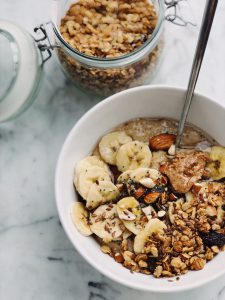Sometimes you just need a mental health day. And sometimes you get one, and then have no idea what to do with all that “me time.” So you end up feeling guilty, unproductive, and more dissatisfied than when you started. If this sounds familiar to you, then maybe it’s time to examine why you end up feeling this way, and what you can do to counteract it. Sure, “me time” can be a time to simply veg out, but if you’re finding that mental health days aren’t improving your mental health, try to figure out exactly what it is you’re feeling. Maybe you’re feeling disorganized or disconnected, and a day scrolling through Netflix or social media isn’t what you need to get back on track. Whatever it is, you can plan out ways to make the most of your “me time,” so you can be ready to tackle whatever life throws at you.
If You’re Feeling Disorganized…
We all get that scattered feeling sometimes. It can really hit you when you’ve got down time, and are free to look around at the clutter surrounding you or obsess over all the tasks that seem to be piling up on you, and that you feel like you should be doing. If your mind is racing and jumping all over the place, and you’re trying to drown it all out with some binge watching, why not try instead:
- Bullet journaling – If you’ve already got a bullet journal started, pull it out. If you haven’t started one, consider doing it now! This creative mix of planner and diary can be whatever you want it to be. You can choose to do anything from track your mental and physical health to plan meals, make shopping lists, and keep track of important dates. Working on your journal a little bit every day could go a long way in calming and focusing your mind.

Take the time to tackle some of your finances!
- Doing some admin – Sounds fun, right? Maybe not, but it can calm you and give you a sense of accomplishment to tackle some non-intimidating aspects of your finances. Think of filing away all of those receipts and paperwork that fill up your drawers and wallet, setting some bills to auto-pay (after you pay them and check them off your list!), or even starting an easy budget with a user-friendly app.
- Decluttering – You don’t have to go crazy and plan for a major overhaul of your whole house, but why not find an area of your bedroom, or a corner of your closet that you can easily reorganize? Pulling out things that you no longer use and donating them to charity can feel freeing- and can make at least a small part of your world look a little tidier and less stress-inducing.
- Jotting it down – It might be time to get back to basics and start making some good old-fashioned to-do lists, but try using some specific techniques to make them less intimidating and more focused. Start your lists with the smallest, easiest accomplished task. Keep only one task at the top of your list at a time, and cross it off as you complete it, then move on to the next.
If You’re Feeling Disconnected…
How is it that we can live in a world where we are constantly connected but still sometimes feel so…disconnected? Scrolling through social media is not always the best way to bring yourself closer to your community or your network, or to humanity at large. Sometimes it just leaves us feeling like we’re missing out on something, or like we’re both isolated and overwhelmed at the same time. If you’re feeling this way, try…

- Calling (or video chatting with) a friend – Sending a text or hopping onto social media are convenient ways to get a message across or superficially see what your friends are up to, but nothing can replace hearing the voice of someone you care about, with all of its emotional inflections.
- Paying for a stranger’s coffee – Sick of spending your time “liking” the posts of hordes of faraway acquaintances? One small act of random, in-person kindness is a simple way to feel an instant connection to another human – a tiny, digital thumbs up has nothing on a real smile on someone’s face.
- Cooking something you love and sharing it with a friend – If you enjoy cooking, it can feel like a creative and productive act, especially if you share your finished product with someone you care about.
- Volunteering – Nothing makes you feel closer to your community than giving something back to it. There are so many ways you can give back; even if you only have a few extra hours of “me time,” you can still find an organization that would be glad of your time.
If You’re Feeling Like You Need Some (Self) Love…
Sometimes having extra time on our hands can mean extra time to criticize ourselves. A mental health day can be whatever you want it to be – but it shouldn’t devolve into that! If you’re already the type that makes to-do lists and beats yourself up if you don’t check off every single thing on it every day, or if you’re staring in the mirror and tearing yourself down, then stop and take some time out to live in the moment and just enjoy you, yourself. Try:
- Switching up how you get moving – If you’re the type that likes to blow off steam with crazy workouts, try slowing down with a yoga class and focus on breathing and feeling the strength of your body. If you’re more into the slow stuff, try a brisk, sweaty run and see how you feel – it might just invigorate you!

- Pampering yourself – Sure, it’s cliched, but sometimes the best thing to do is to treat yourself. What does that look like for you? A mani-pedi? A new haircut and/or color? A massage? Buying something you’ve been saving up for but hesitating on? A simple ice cream cone, hopefully enjoyed with any guilt or other emotions attached to it? In fact, whatever you choose to do, surrender your senses to it and try to remove all feelings of guilt that may be attached to spending money or indulging in extra calories.
- Enjoying the silence – Unplug. Turn off the TV. Read a book. Rediscover your love of listening to music.
- Resting! – That’s right, there’s nothing wrong with taking a much-needed cat nap. Curl up, get cozy, read till you fall asleep, and feel like a carefree kid again.
- Writing – Even if you’re not the creative type, try journaling about what you’re grateful for, or the positive impacts you’ve had on other people’s lives – trust us, there’s a lot of both!
Having some extra “me time” on your hands is a gift, even if it doesn’t feel like it these days! It’s easy, though, to feel paralyzed when you find yourself faced with this gift, and to end up feeling like you missed your chance to refresh and restore. Don’t get us wrong: you don’t need to fill every moment of your life with tasks, you simply need to find ways to add a sense of calm, joy, connection, or satisfaction with yourself into your life. If that sounds like a difficult task, then start with the simple things that we have suggested – you might just be able to add the mental health back into your mental health day!




